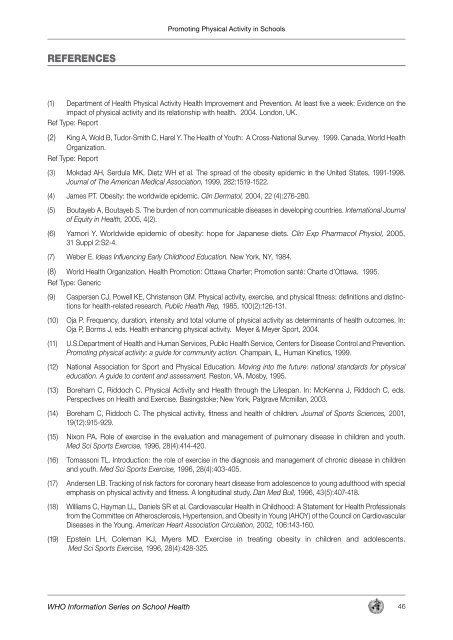WHO INFORMATION SERIES ON SCHOOL HEALTH ... - PAHO/WHO
WHO INFORMATION SERIES ON SCHOOL HEALTH ... - PAHO/WHO
WHO INFORMATION SERIES ON SCHOOL HEALTH ... - PAHO/WHO
Create successful ePaper yourself
Turn your PDF publications into a flip-book with our unique Google optimized e-Paper software.
REFERENCES<br />
Promoting Physical Activity in Schools<br />
(1) Department of Health Physical Activity Health Improvement and Prevention. At least five a week: Evidence on the<br />
impact of physical activity and its relationship with health. 2004. London, UK.<br />
Ref Type: Report<br />
(2) King A, Wold B, Tudor-Smith C, Harel Y. The Health of Youth: A Cross-National Survey. 1999. Canada, World Health<br />
Organization.<br />
Ref Type: Report<br />
(3) Mokdad AH, Serdula MK, Dietz WH et al. The spread of the obesity epidemic in the United States, 1991-1998.<br />
Journal of The American Medical Association, 1999, 282:1519-1522.<br />
(4) James PT. Obesity: the worldwide epidemic. Clin Dermatol, 2004, 22 (4):276-280.<br />
(5) Boutayeb A, Boutayeb S. The burden of non communicable diseases in developing countries. International Journal<br />
of Equity in Health, 2005, 4(2).<br />
(6) Yamori Y. Worldwide epidemic of obesity: hope for Japanese diets. Clin Exp Pharmacol Physiol, 2005,<br />
31 Suppl 2:S2-4.<br />
(7) Weber E. Ideas Influencing Early Childhood Education. New York, NY, 1984.<br />
(8) World Health Organization. Health Promotion: Ottawa Charter; Promotion santé: Charte d’Ottawa. 1995.<br />
Ref Type: Generic<br />
(9) Caspersen CJ, Powell KE, Christenson GM. Physical activity, exercise, and physical fitness: definitions and distinctions<br />
for health-related research. Public Health Rep, 1985, 100(2):126-131.<br />
(10) Oja P. Frequency, duration, intensity and total volume of physical activity as determinants of health outcomes. In:<br />
Oja P, Borms J, eds. Health enhancing physical activity. Meyer & Meyer Sport, 2004.<br />
(11) U.S.Department of Health and Human Services, Public Health Service, Centers for Disease Control and Prevention.<br />
Promoting physical activity: a guide for community action. Champain, IL, Human Kinetics, 1999.<br />
(12) National Association for Sport and Physical Education. Moving into the future: national standards for physical<br />
education. A guide to content and assessment. Reston, VA, Mosby, 1995.<br />
(13) Boreham C, Riddoch C. Physical Activity and Health through the Lifespan. In: McKenna J, Riddoch C, eds.<br />
Perspectives on Health and Exercise. Basingstoke; New York, Palgrave Mcmillan, 2003.<br />
(14) Boreham C, Riddoch C. The physical activity, fitness and health of children. Journal of Sports Sciences, 2001,<br />
19(12):915-929.<br />
(15) Nixon PA. Role of exercise in the evaluation and management of pulmonary disease in children and youth.<br />
Med Sci Sports Exercise, 1996, 28(4):414-420.<br />
(16) Tomassoni TL. Introduction: the role of exercise in the diagnosis and management of chronic disease in children<br />
and youth. Med Sci Sports Exercise, 1996, 28(4):403-405.<br />
(17) Andersen LB. Tracking of risk factors for coronary heart disease from adolescence to young adulthood with special<br />
emphasis on physical activity and fitness. A longitudinal study. Dan Med Bull, 1996, 43(5):407-418.<br />
(18) Williams C, Hayman LL, Daniels SR et al. Cardiovascular Health in Childhood: A Statement for Health Professionals<br />
from the Committee on Atherosclerosis, Hypertension, and Obesity in Young (AHOY) of the Council on Cardiovascular<br />
Diseases in the Young. American Heart Association Circulation, 2002, 106:143-160.<br />
(19) Epstein LH, Coleman KJ, Myers MD. Exercise in treating obesity in children and adolescents.<br />
Med Sci Sports Exercise, 1996, 28(4):428-325.<br />
<strong>WHO</strong> Information Series on School Health 46

















